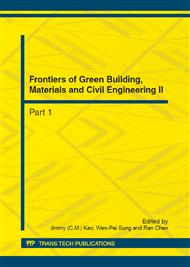p.1065
p.1069
p.1075
p.1079
p.1086
p.1090
p.1095
p.1099
p.1103
Cross-Sectional Optimization of Reinforced Concrete Columns Considering both Economical and Environmental Costs
Abstract:
This work presents the development and implementation of a mathematical formulation for obtaining optimal sections of reinforced concrete columns subjected to uniaxial flexural compression. In order to minimize the cost of the reinforced concrete columns, the amount and diameters of the reinforcement bars and the dimensions of the columns cross sections were considered as discrete variables. The optimization was made by Harmony Search optimization method, a metaheuristic inspired by music performance. Initially, the economical cost of each material (concrete, steel and formwork) were considered, as usual in most optimization strategies. In the sequence, the lesser environmental cost was studied, by considering the Life Cicle Assessment (LCA) to determine the global warming potential. The results obtained led to a different configuration when the objective is a reduction in carbon dioxide (CO2) emissions, regarding the optimum economical cost.
Info:
Periodical:
Pages:
1086-1089
Citation:
Online since:
August 2012
Authors:
Price:
Сopyright:
© 2012 Trans Tech Publications Ltd. All Rights Reserved
Share:
Citation:


